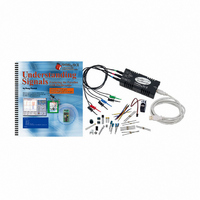28119 Parallax Inc, 28119 Datasheet - Page 31

28119
Manufacturer Part Number
28119
Description
KIT UNDERSTANDING SIGNALS
Manufacturer
Parallax Inc
Datasheet
1.28119.pdf
(137 pages)
Specifications of 28119
Lead Free Status
Contains lead
Accessory Type
Oscilloscope
Interface Type
USB
For Use With/related Products
BASIC Stamp® 2 and Board of Education
Lead Free Status / Rohs Status
Lead free / RoHS Compliant
Available stocks
Company
Part Number
Manufacturer
Quantity
Price
Company:
Part Number:
281197-2
Manufacturer:
TE
Quantity:
20 000
Company:
Part Number:
281197-2
Manufacturer:
MOLEX
Quantity:
2 500
- Current page: 31 of 137
- Download datasheet (5Mb)
Chapter #2: Servo Pulse Square Waves
PULSE WIDTH MODULATION AND HOBBY SERVOS
The focus of this chapter will be to measure and understand the pulses used to control
servos. A servo is a type of tiny motor commonly used in radio-controlled hobby
vehicles, and is also popular in robotics. Among the most difficult tasks for a hobbyist or
amateur robotics enthusiast is to understand the timing of servo control as it relates to
servo positioning.
The Parallax Boe-Bot and Toddler robots use servos for locomotion. Servos typically
have a range of motion of 180°. When modified for continuous rotation, the standard
hobbyist servo becomes a bi-directional, speed-controlled motor.
Servos have three leads: 6 V (red); signal (white), and ground (black). Servos are
controlled by a sequence of pulses. Each pulse is 1-2 ms wide, and there must be ~20 ms
of time between each pulse, as shown in Figure 2-1. The width of this 1-2 ms pulse sets
the servo position (or speed/direction for modified servos) with 1.5 ms being the mid
position (or stopped for modified servos). From a BASIC Stamp’s perspective, this is
quite convenient in that it can use the 20 ms of time between pulses to read sensors,
perform calculations, and execute other code.
Hobby servo control is featured throughout Parallax Stamps in Class documentation. For
more details on servo control, check out the following Stamps in Class texts:
What’s a Microcontroller? Contains simple examples for controlling standard servos.
Robotics with the Boe-Bot The Boe-Bot uses continuous rotation servos to drive its wheels.
servos to achieve its bipedal stride.
See the Further Investigation section at the end of this chapter for details.
Advanced Robotics with the Toddler: The Toddler depends on precision control of standard
Figure 2-1:
Servo control
signal example
A 1 ms pulse
positions the
servo in one
location.
Related parts for 28119
Image
Part Number
Description
Manufacturer
Datasheet
Request
R

Part Number:
Description:
Microcontroller Modules & Accessories DISCONTINUED BY PARALLAX
Manufacturer:
Parallax Inc

Part Number:
Description:
BOOK UNDERSTANDING SIGNALS
Manufacturer:
Parallax Inc
Datasheet:

Part Number:
Description:
COMPETITION RING FOR SUMOBOT
Manufacturer:
Parallax Inc
Datasheet:

Part Number:
Description:
TEXT INFRARED REMOTE FOR BOE-BOT
Manufacturer:
Parallax Inc
Datasheet:

Part Number:
Description:
BOARD EXPERIMENT+LCD NX-1000
Manufacturer:
Parallax Inc
Datasheet:

Part Number:
Description:
CONTROLLER 16SERVO MOTOR CONTROL
Manufacturer:
Parallax Inc
Datasheet:

Part Number:
Description:
BASIC STAMP LOGIC ANALYZER
Manufacturer:
Parallax Inc
Datasheet:

Part Number:
Description:
IC MCU 2K FLASH 50MHZ SO-18
Manufacturer:
Parallax Inc
Datasheet:















